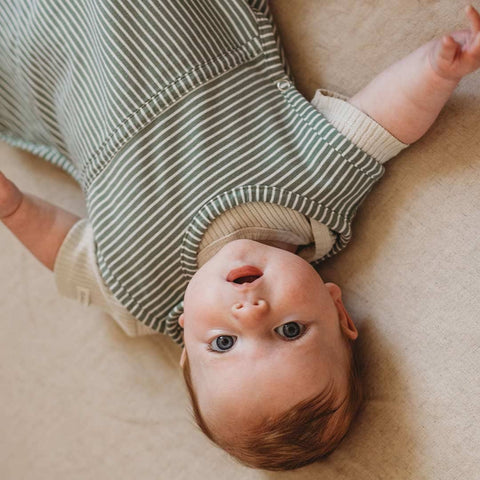How to use your baby sleeping bag
Getting your baby to sleep is one of the many impossible feats of parenthood. To encourage your baby to drift off, it’s important to create the right sleeping conditions so that they are comfortable, free to wriggle, temperature regulated and safe.
Baby sleeping bags can be a great option to keep babies safe and warm throughout the night, and when worn and fitted correctly, can prevent the risk of Sudden Infant Death Syndrome (SIDS).
Let’s go through everything you need to know to keep your little one safe and secure in their baby sleeping bag, so they can sweetly dream all night long, giving you the peace of mind to get some much-needed rest yourself.

Finding the right size sleeping bag
The first step to ensuring the comfort and safety of your baby in their sleeping bag is knowing which size to select.
Babies come in all shapes and sizes, but finding the right size sleeping bag is simple. As long as the neck hole is smaller than your babies head and there is no risk of them slipping down into the sleeping bag, then you can be sure your baby will be safe. You will also need to check that the arm holes fit nice and snug so their hands can’t get inside the bag. Our Merino Kids sleeping bags also have nifty poppers under the arms for extra reassurance.
They will also need plenty of leg room so they can kick and wriggle all night long without feeling restricted. The extra space also helps to regulate your baby’s temperature inside the bag, so they don’t overheat.
Here is a sleeping bag size chart to help you make the right selection:

When your sleeping bag arrives, don’t be alarmed when it looks too long for your little snoozer. They are meant to be long enough to allow for plenty of wriggle room, and space for your baby to grow.
Knowing which tog to use
Much like Duvet’s for adults, baby sleeping bags have their own tog ratings. A tog is a way to measure the thermal resistance of textiles, meaning the tog rating or weight of a baby sleeping bag will determine the temperature of your baby while they sleep.
It’s super important to select the right tog for your baby’s sleeping bag and adapt it where necessary throughout the year. For example, in the summer or during a heatwave, you will need a lower tog to keep your baby cool. In the autumn or winter, you will need to move up to a higher tog to keep your baby cosy.
Here is a handy chart to help you determine which tog is best for your baby based on the temperature of their room:

If you would like to read more about selecting the right tog baby sleeping bag, check out this blog post.
Preparing your baby for sleep
When getting your baby ready for bed with a baby sleeping bag, you need to make sure they have appropriate sleepwear underneath. Baby sleeping bags will most often not have arms, which helps to regulate your baby’s temperature and allow them to wriggle more freely. This means that you need to dress your baby for sleep appropriately depending on the room temperature and their sleeping environment.
Once you have them dressed, you can wrap them up warm in their baby sleeping bag, making sure it is secure properly and the underarm poppers are all done up.
Carry out your usual night-time routine, whether this consists of a nice long cuddle, a bedtime story, or a lullaby, it’s important to get your little one nice and calm and content before placing them in their cot to sleep. Dim the lights and switch on your white noise machine if you are using one. Natural Baby Shower have a great range of adorable baby sleeping aids which work a treat to help your little dreamer relax and drift off.
It’s really important to monitor your baby’s temperature, especially as the seasons change. Check your baby’s temperature by gently feeling the back of their neck and if they feel hot or damp then we would suggest removing a few layers to cool them down or move to a lighter tog if you have one.
For peace of mind, you’ll find that one of the many benefits of Merino Kids’ sleeping bags is that merino wool is naturally moisture-wicking, so your little one can stay dry and comfortable from dusk till dawn.

When to size up
You can use our handy size guide above to help you select the right size for your baby’s height, but you should also be able to tell yourself when your baby might need to size up.
Sleeping babies are little wrigglers, they kick their legs and move around all the time, and their sleeping bag shouldn’t restrict this. If it looks like their sleeping bag is too tight around their legs, too close to the end of their tiny toes or too tight around their arms or neck, then you should definitely buy the size up.
Because sleeping bags are made to last a long time, and offer plenty of extra leg room, you shouldn’t need to size up often.
We hope this handy how-to will help you find the perfect sleeping bag for your little dreamer to help them stay snug as a bug in a rug.
If you still have some questions around choosing a baby sleeping bag, the benefits of using them, the types you can buy or anything else to consider, check out this baby sleeping bag buying guide made by Natural Baby Shower.







